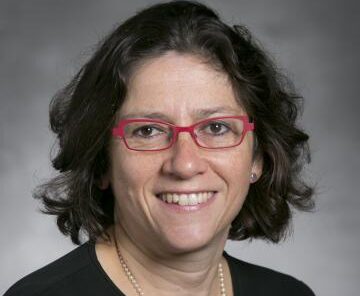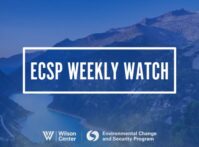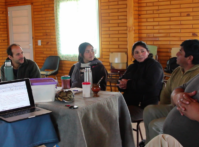-
Thought-leaders and Frontline Workers in Environmental Peacebuilding: An Oral History | Dr. Erika Weinthal
April 12, 2024 By Wilson Center Staff
Today’s episode of New Security Broadcast is hosted by ECSP in collaboration with the Environmental Peacebuilding Association as part of a special series: “Thought-leaders and Frontline Workers in Environmental Peacebuilding: An Oral History.” The series features interviews with academics, practitioners, and frontline workers to trace the history and evolution of the field of environmental peacebuilding.
Today’s episode of New Security Broadcast is hosted by ECSP in collaboration with the Environmental Peacebuilding Association as part of a special series: “Thought-leaders and Frontline Workers in Environmental Peacebuilding: An Oral History.” The series features interviews with academics, practitioners, and frontline workers to trace the history and evolution of the field of environmental peacebuilding.
In this episode, ECSP’s Claire Doyle speaks with Dr. Erika Weinthal, who is the Lee Hill Snowdon Professor of Environmental Policy at Duke University. Dr. Weinthal specializes in global environmental politics and environmental security with a particular focus on water and energy. She is also part of the United Nations Environment Programme’s Expert Advisory Group on Environment, Conflict, and Peacebuilding. Dr. Weinthal shares about her early involvement in the field of environmental peacebuilding, why water was a salient topic right at the outset, how academics, practitioners, and policymakers shaped the field together, where she thinks the field is headed, and more. Select quotes from the interview are featured below.
On what drew Dr. Weinthal to the intersection of environment and peace:
“When I began my research, it was about the question of water cooperation and conflict. I was trying to understand what was happening in the context of state collapse with the fall of the Soviet Union and new independent states in Central Asia. I wanted to understand how institutions were being redesigned to manage water, and whether these new states would maintain a sense of cooperation rather than compete over water.”
I was looking at the questions that are central to environmental peacebuilding, we just didn’t call it environmental peacebuilding back then. I think where it finally became wrapped up under the rubric of environmental peacebuilding was when I was a graduate student, or maybe a junior professor, I was asked by Ken Conca and Geoff Dabelko to participate in a book workshop that ultimately produced the volume on environmental peacemaking, largely because of my work in the Aral basin in Central Asia.”
On why water emerged as a key theme of the environmental peacebuilding field:
“Going back half a century at this point, people understood water was necessary for people’s livelihoods, for people’s health, for the economies of the countries that border water systems. You had global attention through the UN, but also academics who were trying to figure out why it was that you were actually seeing cooperation over water resources where you didn’t see cooperation over a lot of other issue areas.
So when Ken Conca and Geoff Dabelko brought together scholars to work on the environmental peacemaking volume, when we started looking at the chapters, they were all on water. It raised the issue of what it was about water that was so unique that led to more cooperation than conflict.”
On the early days of environmental peacebuilding as a field:
“This is a field that came together from so many different disciplines and from practitioner perspectives. It did not emerge out of the field of environmental security. Rather, I think the field grew largely within the context of the collapse of the Soviet Union, and acknowledging that war just looked different in the 1990s.
There was a lot more attention focused on the role of natural resources as a cause of war and the role they could play in extending war through the sale of gas, oil, minerals, diamonds, and timber. When people started talking, this whole notion of these linkages between the environment, peacebuilding, and conflict began to congeal. This was really important because, unlike other fields, the field of environmental peacebuilding really is a dialogue between practitioners, policymakers and academics, and I think in many ways that’s what distinguishes the field.”
On the focus shifting from interstate to intrastate conflicts and post-conflict settings:
“The challenge was that for those who study war, they’re looking at the amount of battle deaths to understand what constitutes a war. A conflict takes many different forms. I think that’s a difference in the field of environmental peacebuilding because when we study conflict, we’re not just looking at battle deaths, but we’re looking at competition over resources, different forms of violence, different power asymmetries, and people’s access to water.
As one started looking at conflict broadly in the world, we were also witnessing a spike in civil wars. In those conflicts, there was a really clear connection to the sale of timber or the sale of gold and diamonds in a certain set of countries. There was a need to really look at the internal politics, look at the internal political economy to understand the role of natural resources and conflict.”
On the field’s evolution as reflected in policy and programming:
“Part of the USAID water and conflict toolkit, which I think is really important, is that there’s a shift from just focusing on interstate water cooperation and conflict. But, that doesn’t mean there’s not a lot of challenges in the water sector, especially when it comes to environment and peacebuilding. There are still many instances where communities will fight over water and this is going to become a bigger issue with the climate crisis as we’re seeing shifting patterns of rainfall, drought, and varied access to water. So there’s even greater attention to what’s happening at the local level because of the climate crisis.
One of the issues is we’re having greater attention paid to nexus issues. So the toolkit captures some of that: thinking about the relationship between water and land, for example. Also thinking about the relationship between the humanitarian sector and the development sector because often a lot of interventions begin when countries are facing a humanitarian crisis, but they then bleed into development work.”
On her experience as a woman in the field:
“Thinking about the issue of gender, some of the key work early on in partnerships with the United Nations and others has been to think about the intersection between gender, natural resources, and the environment. UN Women is working with the United Nations Environment Program, but also engaging scholars to comment on the work and to participate in those dialogues. Some of the most exciting work that is happening now is on topics such as women in water diplomacy. Just watching that community grow is phenomenal.
When I was in Central Asia, water was a very male field. Now I go to meetings and see this new generation of water scientists, water scholars, water practitioners coming from Central Asia or from the Nile Basin and talking about water diplomacy, but also water peacebuilding. It is because as a community of practice, we’ve been quite attentive to ensuring that it is a field that is welcoming and inclusive.”
On what is next for the field:
“I think the field is recognizing some of its limitations, in a good way. We’re not going in, naive, and saying we can solve conflicts and bring about peace if we just focus on the environment and natural resources. We’re paying more attention to the situations where we have and haven’t seen successes. As we look at the environment, natural resources, and the post-conflict phase, to really try to hone in to very specific cases and to try to understand what was it about those particular contexts where we’ve seen a positive outcome. I also think there’s a lot more work being done on different types of participatory processes, which is really important because not all participatory processes are the same.
I think we need to also think about the role of the environment and natural resources within war. We often wait until wars end to think about what it means for rebuilding. But in so many parts of the world, especially in the Middle East, we’re seeing longer and longer protracted conflicts. The environmental peacebuilding community really [needs to] engage with the humanitarian community and the development community to think about not just ending wars, but human security and protecting lives and the wellbeing of people.”
Photo credit: Erika Weinthal Headshot, courtesy of Erika Weinthal.
Topics: climate change, community-based, conflict, environment, environmental justice, Environmental Peacebuilding Oral History, environmental peacemaking, environmental security, extreme weather, flooding, humanitarian, international environmental governance, meta, New Security Broadcast, podcast, security, water, water security
 A Publication of the Stimson Center.
A Publication of the Stimson Center.








